Abstract
In this study, we present a complete description of the addition of a model nucleophile to the nitroaromatic ring in positions occupied either by hydrogen (the first step of the SNAr-H reaction) or a leaving group (SNAr-X reaction) using theoretical parameters including aromaticity (HOMA), electrophilicity and nucleophilicity indices. It was shown both experimentally and by our calculations, including kinetic isotope effect modeling, that the addition of a nucleophile to the electron-deficient aromatic ring is the rate limiting step of both SNAr-X and SNAr-H reactions when the fast transformation of σH-adduct into the products is possible due to the specific reaction conditions, so this is the most important step of the entire reaction. The results described in this paper are helpful for better understanding of the subtle factors controlling the reaction direction and rate.
1. Introduction
Nucleophilic aromatic substitution of halogens in halonitroarenes is one of the fundamental processes of organic chemistry widely used for industrial and laboratory organic synthesis [1,2,3]. The reaction proceeds via the addition of nucleophiles to the aromatic rings at positions occupied by halogen X to form σX-adducts followed by spontaneous departure of X− anions to give the substitution products. The addition is connected with dearomatization of the rings, whereas formation of the product by departure of X− results in rearomatization, thus, as a rule, the addition is the slow, rate limiting step of the reaction. This mechanism, formulated by J.F. Bunnett [4,5], was confirmed in numerous mechanistic studies and presently is generally accepted [6]. It has been also confirmed by numerous quantum chemical calculations of the reaction pathways between halonitrobenzenes and nucleophiles [7,8,9,10,11,12,13,14,15,16,17,18]. These calculations showed that depending on the structure of the reactants—nitroarenes and nucleophiles—the σX-adduct can either be an intermediate, i.e., is located in a local energy minimum on the potential energy surface (PES) of the reaction, or a transition state [19].
The nitro group in halonitrobenzenes activates three positions of the ring (two ortho and one para position) towards nucleophilic addition, thus the nucleophiles can add also at positions occupied by hydrogen. Indeed, there are a few old reports of reactions that proceed via addition of nucleophiles to p- and o-chloronitrobenzenes at positions occupied by hydrogen and further conversions of the produced σH-adducts, such as von Richter reaction [20] or formation of benzisoxazoles [21]. Some years ago, it was shown that the addition of nucleophiles to halonitroarenes at positions occupied by hydrogen proceeds faster than at those occupied by halogens and that there are a few general ways of conversion of the initially formed σH-adducts into products of nucleophilic substitution of hydrogen SNAr-H, such as oxidation [22,23], vicarious nucleophilic substitution (VNS) [24,25], etc. (Scheme 1). In fact, oxidative nucleophilic substitution of hydrogen, ONSH, vicarious nucleophilic substitution of hydrogen, VNS, and some other variants of SNAr-H are presently well recognized and widely used processes in organic synthesis [3,26,27,28,29,30,31,32]. On the basis of these results, it was concluded that classical SNAr-X of halogens is a secondary process preceded by fast and reversible formation of the σH-adducts [33].
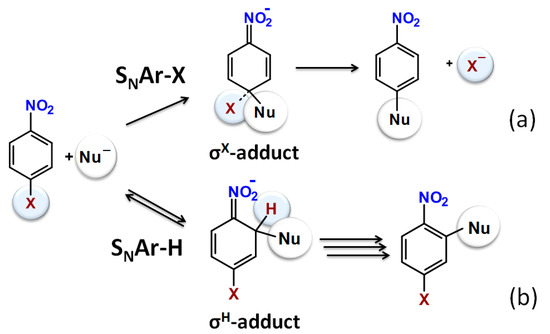
Scheme 1.
Nucleophilic substitution of halogen SNAr-X (a) and hydrogen SNAr-H (b) in para substituted nitrobenzenes (X = halogen).
However, even in recent publications on the mechanism of SNAr reactions this situation was not taken into account [3,34]. Moreover, in all quantum chemical calculations of the energy profiles of the addition of nucleophiles to halonitrobenzenes only the addition at positions occupied by halogens has been considered [7,8,9,10,11,12,13,14,15,16,17,18,34]. It is really surprising, because calculations of a reaction between two reactants should look for the pathways that proceed via transition states (TS) of the lowest free energies, thus they have ignored faster addition at positions occupied by hydrogen.
Previously we have presented results of DFT calculations of the reactions between a model nucleophile: carbanion of chloromethyl phenyl sulfone 1 and three model nitroarenes: nitrobenzene 2, p-fluoro- and p-chloronitrobenzenes 3 and 4 for the gas phase and DMF solutions. These calculations have shown that the addition at positions occupied by hydrogen proceeds via TS of lower free energy than at those occupied by halogens (Figure 1); thus, they are in agreement with the experimental results. On this basis, a real, corrected mechanism of nucleophilic aromatic substitution has been formulated [35,36,37]. The model nucleophile (chloromethyl phenyl sulfone anion) has been chosen as an example, which, due to its nature, is much less affected by the solvent’s effects contrary to the other most common protic or polar nucleophiles [35].
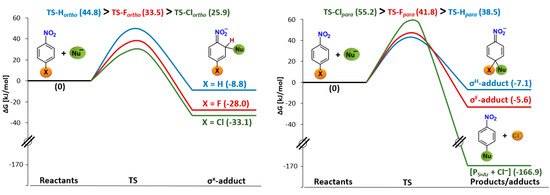
Figure 1.
Potential energy profiles for the limiting step of SNAr-H (left) and SNAr-X (right) reactions between model nuclephile 1 and para substituted halonitrobenzenes constructed based on our previous computation results published elsewhere [35].
The aim of this paper is to present a full mechanistic picture of nucleophilic aromatic substitution in halonitroarenes and nitrobenzene embracing such subtle features as changing aromaticity of the nitroarenes as well as electrophilicity of nitroarenes and nucleophilicity of the carbanion in the addition process, kinetic isotope effects and effects of substituents on the rates of the addition on the basis of DFT calculation and experimental results.
2. Results and Discussion
As the model nucleophile in our calculations, we have used the carbanion of chloromethyl phenyl sulfone 1 that was used in experimental mechanistic studies of SNAr-H reaction. It was also used in the previous calculations of the energy profiles of the reaction with nitrobenzene 2, p-fluoronitrobenzene 3 and p-chloronitrobenzene 4 (Scheme 2).
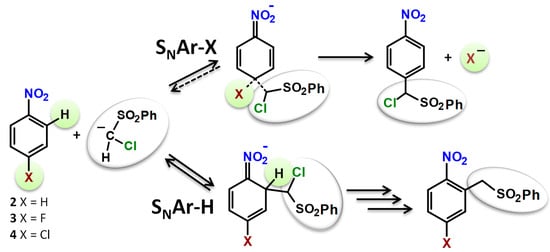
Scheme 2.
Nucleophilic substitution of halogen SNAr-X (upper) and hydrogen SNAr-H (lower) in para substituted nitrobenzenes.
2.1. Aromaticity
Nucleophilic addition to the nitroaromatic rings, regardless of positions of the addition, is connected with dearomatization. In fact, the intermediate adducts, particularly σH-adducts, are relatively stable entities and have the structure of cyclohexadienenitronate anions [38]. It is therefore of great interest to follow the change of the aromaticity in the course of the reaction.
The results of experimental studies, particularly rates of the reactions, can clarify some key elements of the mechanism. In the case of SNAr-X and SNAr-H, they can be interpreted in terms of changes of aromaticity in the reaction course. Nonaromatic structure of σH-adduct to p-substituted nitrobenzenes was directly determined by observation of its 1H NMR spectra [38].
These experimental results provide information about the key steps of the reaction. Changes of aromaticity in the course of nucleophilic addition can be followed by quantum chemical calculations. In order to follow electronic reorganization during this process, calculations based upon the Harmonic Oscillator Model of Aromaticity (HOMA) [39] were performed. When the nucleophile approaches the nitroarene ring and the distance between them decreases, the excess of negative charge affects the shape of the ring. Figure 2 shows the HOMA aromaticity index as a function of the progress of the reaction between our model nucleophile, the anion of chloromethyl phenyl sulfone 1 and 2, 3 and 4. In all cases the addition to the ring at positions occupied by hydrogen: ortho- and para- of 2 and ortho- of 3 and 4, size of the ring increases and it loses planarity. The circumference of the ring increases in all these cases by about 2% (see Supplementary Materials: S6, S7). It is therefore evident that the loss of aromaticity in the case of the σH-adducts is the largest, in agreement with experiments. It is a different situation in the case where the nucleophile adds to p-halonitrobenzenes at the position occupied by halogen. The addition at the position occupied by fluorine in 3 results in formation of the σF-adduct, located in a minimum of the free energy on the reaction profile. This adduct possesses higher aromaticity than σH-adduct and circumference of the ring increases by ca. 1.7%, perhaps because the electron withdrawing fluorine atom accepts a partially negative charge of the ring.
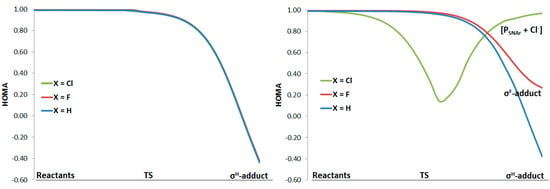
Figure 2.
The Harmonic Oscillator Model of Aromaticity (HOMA) aromaticity index for the addition to the ortho (left) and para position (right), calculated at PBE1PBE/6-31 + G(d) level of theory (PSNAr stands for the product of the SNAr reaction).
The addition of 1 at position para of 4 occupied by chlorine results in the formation of the structure identical to the σCl adduct, however, it is not located at the local minimum of ΔG on the reaction path but at the saddle point, thus it is the transition state (Figure 3). This phenomenon has been discussed in recent reports by Fernández et al. [19] and earlier in the case of electrophilic reactions by Gwaltney et al. [40]. Additionally, the observation that the σCl-adduct is the transition state structure was omitted in a very innovative work by Ormazábal-Toledo et al. [16] in which the authors introduce the calculation methodology used by us in the next parts of the present work. The lowest aromaticity of the system is observed after the transition state when the rearomatization process starts with the departure of the chloride anion. The negative charge is removed from the ring with the leaving group and the nitrobenzene ring relaxes into the symmetric planar shape. The circumference of the ring increases by 1.9% when the σCl-adduct is formed as the transition state.
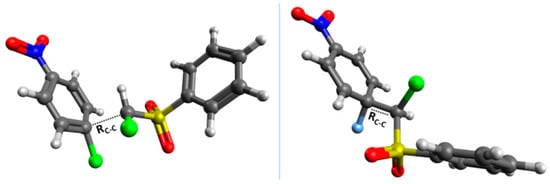
Figure 3.
Optimized structures of the σCl-adduct as a transition state (left) where the distance between reaction centers is RC-C = 2.38 Å and the σF-adduct as an equilibrium structure (right) where RC-C = 1.56 Å.
This part of the investigation shows clearly that the SNAr reaction substitution of fluoride proceeds fastest because during the reaction there is the smallest aromaticity loss, so the atomic system has the best possibility to recover aromaticity. The replacement of chloride is slower because the larger loss of aromaticity is observed during the reaction. The σCl-adduct is not a stable intermediate product, which is why the SNAr reaction between p-chloronitrobenzene and the nucleophile is irreversible. These observations based on the aromaticity are in agreement with the kinetics. Finally, the addition at positions occupied by hydrogen smoothly leads to the highest aromaticity loss and the formation of stable intermediate σH-adducts, which can be transformed into the final SNAr-H product by several ways under the appropriate reaction conditions [24,25,26,27,28,41,42,43,44,45].
2.2. Electrophilicity and Nucleophilicity
The concepts of nucleophilicity and electrophilicity are an inseparable part of nucleophilic substitution processes. Over the years, many attempts to determine their absolute and relative values, both experimentally [46,47,48,49,50,51,52,53,54,55,56] and theoretically [16,18,57,58,59,60], have been reported. In the particular case of nucleophilic aromatic substitution of halogens (SNAr-X) and hydrogen (SNAr-H), in which the initial step is nucleophilic addition to the electron-deficient ring, electrophilicity is the factor deciding the rate of addition.
Thus, the effect of substituents on the rate of the addition can be considered as the effect on electrophilicity of the ring. Although, as a rule, the addition is the rate limiting step of SNAr reaction, the effect of substituents on the rate of substitution of halogen in halonitrobenzenes containing various substituents cannot be considered as a measure of electrophilicity of the ring, because it depends on the kind of halogens and, particularly, because it is a secondary reaction preceded by fast and reversible addition at positions occupied by hydrogen. Thus, real electrophilic activity of substituted nitroarenes was determined in relation to the rate of the addition reaction at positions occupied by hydrogen. For technical reasons, relative rates of the addition of the model nucleophile 1 were determined in relation to the rate of addition at position ortho of nitrobenzene. These experimentally determined electrophilicities of p-substituted nitrobenzenes are in good correlation with the calculated electrophilicity indices ω+ of these nitroarenes (Table 1, Figure 4). These data describe electrophilicity of the nitroarenes before the reaction. Changes of electrophilicity of nitroarenes and nucleophilicity of 1 along the reaction path can be tracked only by computation [60]. Following the reaction coordinates, calculations of nucleophilicity and electrophilicity were performed (for more details please consult Supplementary Information, SI) for selected parts of the atomic system16, according to models shown in Figure 5.

Table 1.
Experimental relative activities [61] and calculated electrophilicity potential ω+ (eV) of para substituted nitro benzenes.
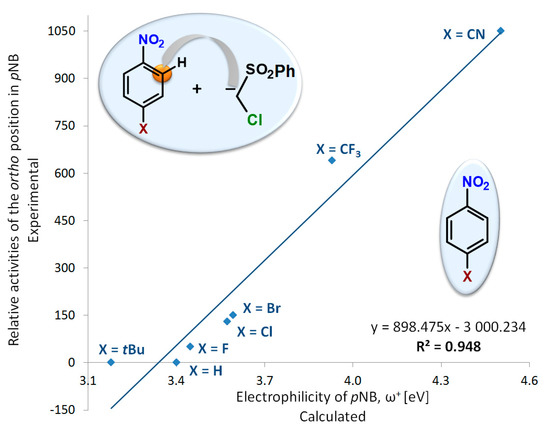
Figure 4.
The correlation between the calculated electrophilicity potential ω+ (eV) of pNB and the experimental relative activities of the ortho position in the case of the SNAr-H reaction.
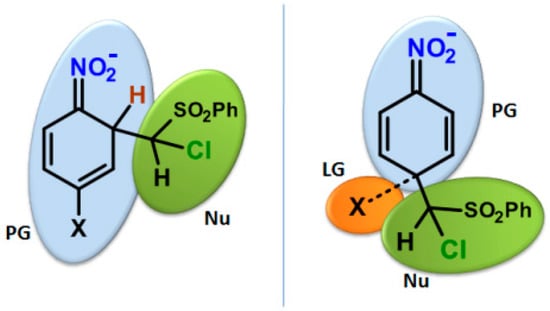
Figure 5.
Models of σH- and σX-adducts as SNAr-H and SNAr-X reaction intermediates with breakdown into PG—permanent group, Nu—nucleophile, and LG—leaving group.
Based on conceptual density functional theory [62,63], the electrophilicity and nucleophilicity indices for the addition of the selected nucleophile in the ortho position of nitrobenzene derivatives were calculated, Figure 6.
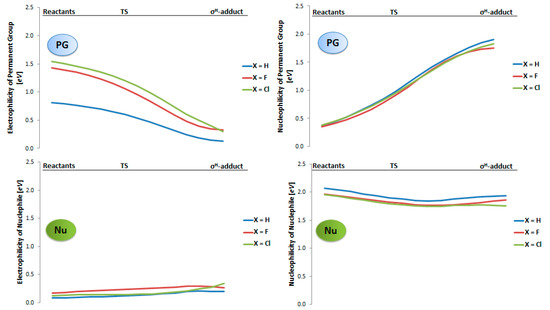
Figure 6.
Changes of electrophilicity for permanent group (upper left), nucleophile (lower left) and nucleophilicity for permanent group (upper right) and nucleophile (lower right) during the nucleophilic substitution in the ortho position.
It was proven by the calculated activation barriers [35] (Figure 1) that the rate of σH-adduct formation is strictly related to substituent effects in the aromatic ring. The electron-withdrawing effect of the halogen in the para position contributes to the activation of the ortho position towards nucleophilic attack. In this case the results obtained for p-fluoro-, p-chloro- and unsubstituted nitrobenzene are very similar. The upper left diagram in Figure 6 shows the calculated electrophilicity of permanent group (PG). Each nitrobenzene derivative has different electrophilic character, thus the potential to react with the nucleophile decreases accordingly: p-chloro- > p-fluoro- > unsubstituted nitrobenzene. The electrophilicity of PG fell rapidly en route to the formation of σH-adducts and it slightly increased in the nucleophile atomic system (lower left diagram, Figure 6). The upper right diagram shows that the calculated nucleophilicity of the permanent group increases during the addition in the ortho position. Nucleophilicity values of the permanent group are mainly affected by the type of the nucleophile and its character as a donor of extra electron density. This causes the differences of nucleophilicity between nucleophile acceptors to be less pronounced.
On the other hand, the same factors in the form of electrophilicity and nucleophilicity indices for the SNAr reaction were calculated. The results suggest that the electrophilicity of the permanent group in the case of para substitution is very similar to the loss of aromaticity and the nucleophilicity trend of PG is reversed, Figure 7.
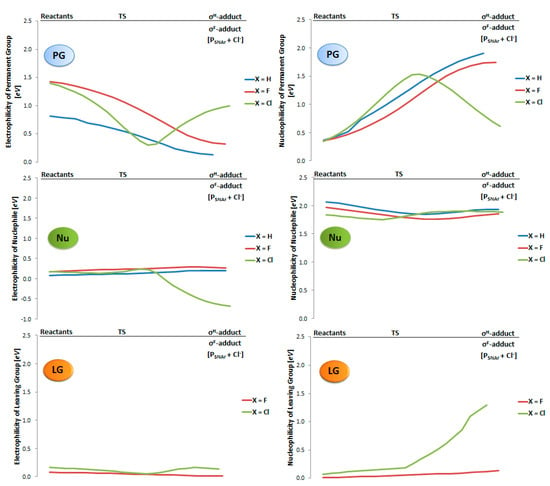
Figure 7.
Changes of electrophilicity for permanent group (PG) (upper left), leaving group (LG) (middle left) nucleophile (Nu) (lower left) and nucleophilicity for permanent group (PG) (upper right), leaving group (LG) (middle right) and nucleophile (Nu) (lower right) during nucleophilic substitution in the para position.
For p-chloronitrobenzene, the electrophilicity decreases until the transition state structure is formed; after the chloride anion detaches, the potential to accept an electron from the environment increases. For p-fluoronitrobenzene and nitrobenzene, the trends of the factors are very similar to those obtained for the reaction in the ortho position. The reactions in the para position of p-fluoronitrobenzene and nitrobenzene lead to the formation of σF-adduct and σH-adduct, respectively. That observation is also consistent with the aromaticity changes and the properties of the formed σ-adducts, where the σF-adduct and the σH-adduct are stable intermediates, and the σCl-adduct is a transition state structure. The substitution of the chlorine atom as a first order reaction is also visible in the case of nucleophilicity change trends of the leaving group, where this parameter increases for the chloride ion after its departure from the nitrobenzene ring. All of the presented trends for SNAr-X and SNAr-H reactions seem to reproduce reliably the nucleophilicity and electrophilicity changes along the electron reorganization path during the bond formation-bond breaking processes between the nucleophile and the nitrobenzene derivatives.
2.3. Kinetic Isotope Effect
Studies of kinetic isotope effects, KIEs, are an important tool for clarification of mechanisms of organic reactions. Since differences of rates of reactions in which isotopes are involved are functions of their mass differences, KIEs of hydrogen 1H vs. 2D are the most often studied. Nevertheless, on the basis of the KIEs of fluorine 18F vs. 19F, it was shown that in SNAr of fluorine in 2,4-dinitrofluorobenzene in the reaction with piperidine, the addition or the elimination can be the rate limiting step depending on the solvent [63,64]. On the other hand, determination of KIEs of hydrogen H vs. D was of great importance for determination (elaboration) of the mechanism of SNAr-H reactions [65,66]. Thus, it was shown that the addition of the model carbanion 1 at positions occupied by hydrogen of 4-bromo-2-deuteronitrobenzene proceeds somewhat slower than at identically activated positions occupied by deuterium, KIE ≈ 0.8. Calculations of the energy profiles for this reaction in the gas phase by three DFT methods gave the results between 0.62 and 0.82, which are in a good agreement with the experimental data. These results show that calculation of KIE can be quite useful in studying reaction mechanisms, especially that it is much simpler compared to the experiment.
3. Conclusions
In conclusion, the detailed mechanistic picture of both variants: SNAr-X and SNAr-H of nucleophilic aromatic substitution pathways in halonitroarenes was fully described by the reactivity indices and kinetic isotope effect. The latter shows unequivocally that the addition of the nucleophile to the aromatic ring is the rate-determining step of all variants of SNAr-X mechanism and of SNAr-H, in specific conditions where the σH-adduct can be easily transformed to the products. Our results showed that there is a significant difference between reaction mechanisms of the substitution of chlorine and fluorine atoms. The first reaction is a single step process, in which the σCl-adduct is a transition state. In contrast, in the case of the substitution of the fluorine atom, the σF-adduct is an intermediate product, which is always the case in the SNAr-H reactions. Our results show that the formation of σH-adducts is preferred and, providing that they can undergo fast further transformations, the SNAr-H reaction is dominating over the SNAr-X. Fluoronitrobenzene is a special case because both σH- and σF-adducts are intermediate products so the relative rate of the substitution of fluorine and hydrogen depends on the reaction conditions. Finally, we have shown that reactivity indices, when used correctly, are a very useful tool for describing mechanisms of the reactions between aromatic nitro compounds and nucleophiles.
Supplementary Materials
Description of computational procedures and method selection, geometries, and energies of the studied structures.
Author Contributions
K.B. coordinated the study, conceived of the methodology plan, prepared graphics and led its design, performed the computations, analyzed data, and prepared a draft of the manuscript. M.M. conceived of the mechanistic study, M.M. and W.D. participated in the coordination of the project, contributed to the formulation of the final conclusions, and helped to draft the manuscript. All authors have read and agreed to the published version of the manuscript.
Funding
This research was founded by National Science Centre, Poland, Grant No. 2018/02/X/ST4/02643.
Acknowledgments
This work has been financed by the National Science Centre, Poland, Grant No. 2018/02/X/ST4/02643. We express our thanks to the Wroclaw Center for Networking and Supercomputing (WCSS) and Interdisciplinary Centre for Mathematical and Computational Modeling (ICM) in Warsaw (Grant No. G50-2) for providing computer time and facilities. The authors wish to thank Artur Ulikowski for valuable discussion.
Conflicts of Interest
The authors declare no conflict of interest.
References
- Miller, J. Aromatic Nucleophilic Substitution; Elsevier: New York, NY, USA, 1968. [Google Scholar]
- Caron, S.; Ghosh, A. Practical Synthetic Organic Chemistry; John Wiley & Sons Inc.: Hoboken, NJ, USA, 2011; pp. 237–253. [Google Scholar]
- Crampton, M.R. Arene Chemistry: Reaction Mechanisms and Methods for Aromatic Compounds; John Wiley & Sons: Hoboken, NJ, USA, 2016. [Google Scholar]
- Bunnett, J.F. Mechanism and Reactivity in Aromatic Nucleophilic Substitution Reactions. Quart. Rev. Chem. Soc. 1958, 12, 1–16. [Google Scholar] [CrossRef]
- Bunnett, J.F.; Zahler, R.E. Aromatic Nucleophilic Substitution Reactions. Chem. Rev. 1951, 49, 273–412. [Google Scholar] [CrossRef]
- Terrier, F. Modern Nucleophilic Aromatic Substitution; Wiley-VCH: Weinheim, Germany, 2013. [Google Scholar]
- Nudelman, N.S.; MacCormack, P. Theoretical Calculations of Chemical Interactions. Part 5. 1,1-Disubstituted 2,4,6-Trinitrocyclohexadienylide (’Meisenheimer’) Complexes. J. Chem. Soc. Perkin Trans. 2 1987, 227–229. [Google Scholar] [CrossRef]
- Dotterer, S.K.; Harris, R.L. Mndo Study of Nucleophilic Aromatic Substitution. J. Org. Chem. 1988, 53, 777–779. [Google Scholar] [CrossRef]
- Simkin, B.Y.; Gluz, E.B.; Glukhovtsev, M.N.; Minkin, V.I. Theoretical Study of Mechanisms of Aromatic Nucleophilic Substitution in the Gas Phase. J. Mol. Struct. Theochem. 1993, 284, 123–137. [Google Scholar] [CrossRef]
- Glukhovtsev, M.N.; Bach, R.D.; Laiter, S. Single-Step and Multistep Mechanisms of Aromatic Nucleophilic Substitution of Halobenzenes and Halonitrobenzenes with Halide Anions: Ab Initio Computational Study. J. Org. Chem. 1997, 62, 4036–4046. [Google Scholar] [CrossRef]
- Um, I.H.; Min, S.W.; Dust, J.M. Choice of Solvent (Mecn Vs H2o) Decides Rate-Limiting Step in Snar Aminolysis of 1-Fluoro-2,4-Dinitrobenzene with Secondary Amines: Importance of Brønsted-Type Analysis in Acetonitrile. J. Org. Chem. 2007, 72, 8797–8803. [Google Scholar] [CrossRef]
- Acevedo, O.; Jorgensen, V.L. Solvent Effects and Mechanism for a Nucleophilic Aromatic Substitution from Qm/Mm Simulations. Org. Lett. 2004, 6, 2881–2884. [Google Scholar] [CrossRef] [PubMed]
- Roberts, D.W.; Aptula, A.O.; Patlewicz, G.Y. Chemistry-Based Risk Assessment for Skin Sensitization: Quantitative Mechanistic Modeling for the Snar Domain. Chem. Res. Toxicol. 2011, 24, 1003–1011. [Google Scholar] [CrossRef]
- Imoto, M.; Matsui, Y.; Takeda, M.; Tamaki, A.; Taniguchi, H.; Mizuno, K.; Ikeda, H. A Probable Hydrogen-Bonded Meisenheimer Complex: An Unusually High Snar Reactivity of Nitroaniline Derivatives with Hydroxide Ion in Aqueous Media. J. Org. Chem. 2011, 76, 6356–6361. [Google Scholar] [CrossRef]
- Jose, K.B.; Cyriac, J.; Moolayil, J.T.; Sebastian, V.S.; George, M. The Mechanism of Aromatic Nucleophilic Substitution Reaction between Ethanolamine and Fluoro-Nitrobenzenes: An Investigation by Kinetic Measurements and Dft Calculations. J. Phys. Org. Chem. 2011, 24, 714–719. [Google Scholar] [CrossRef]
- Ormazábal-Toledo, R.; Contreras, R.; Campodónico, P.R. Reactivity Indices Profile: A Companion Tool of the Potential Energy Surface for the Analysis of Reaction Mechanisms. Nucleophilic Aromatic Substitution Reactions as Test Case. J. Org. Chem. 2013, 78, 1091–1097. [Google Scholar] [CrossRef] [PubMed]
- Ormazabal-Toledo, R.; Contreras, R.; Tapia, R.A.; Campodonico, P.R. Specific Nucleophile-Electrophile Interactions in Nucleophilic Aromatic Substitutions. Org. Biomol. Chem. 2013, 11, 2302–2309. [Google Scholar] [CrossRef] [PubMed]
- Contreras, R.; Andres, J.; Safont, V.S.; Campodonico, P.; Santos, J.G. A Theoretical Study on the Relationship between Nucleophilicity and Ionization Potentials in Solution Phase. J. Phys. Chem. A 2003, 107, 5588–5593. [Google Scholar] [CrossRef]
- Fernández, I.; Frenking, G.; Uggerud, E. Rate-Determining Factors in Nucleophilic Aromatic Substitution Reactions. J. Org. Chem. 2010, 75, 2971–2980. [Google Scholar] [CrossRef]
- Von Richter, V. Technical Translations. Chem. Ber. 1871, 4, 459. [Google Scholar]
- Davis, R.B.; Pizzini, L.C. Condensation of Aromatic Nitro Compounds with Acrylacetonitriles.1,2 Ii. Some P-Substituted Nitrobenzenes. J. Org. Chem. 1960, 25, 1884–1888. [Google Scholar] [CrossRef]
- Mąkosza, M.; Staliński, K. Oxidative Nucleophilic Substitution of Hydrogen in Nitroarenes. Chem. Eur. J. 1997, 3, 2025–2031. [Google Scholar] [CrossRef]
- Malykhin, E.V.; Kolesnichenko, G.A.; Shteingarts, V.D. Reaction of aromatic-compounds with nucleophilic-reagents in the liquid ammonium medium. 5. mechanism and hydroxylation orientation of para-substituted nitrobenzene with potassium hydroxide. Zh. Org. Khim. 1985, 21, 1150–1159. [Google Scholar]
- Goliński, J.; Makosza, M. “Vicarious” Nucleophilic Substitution of Hydrogen in Aromatic Nitro Compounds. Tetrahedron Lett. 1978, 19, 3495–3498. [Google Scholar] [CrossRef]
- Mąkosza, M.; Winiarski, J. Vicarious Nucleophilic Substitution of Hydrogen. Acc. Chem. Res. 1987, 20, 282–289. [Google Scholar] [CrossRef]
- Mąkosza, M. Nucleophilic Substitution of Hydrogen in Nitroarenes: A New Chapter of Aromatic Chemistry. Synthesis 2011, 2011, 2341–2356. [Google Scholar] [CrossRef]
- Mąkosza, M. Nucleophilic Substitution of Hydrogen in Electron-Deficient Arenes, a General Process of Great Practical Value. Chem. Soc. Rev. 2010, 39, 2855–2868. [Google Scholar] [CrossRef] [PubMed]
- Chupakhin, O.N.; Charushin, V.N.; Van der Plas, H.C. Nucleophilic Aromatic Substitution of Hydrogen; Academic Press: New York, NY, USA, 1994. [Google Scholar]
- Mąkosza, M.; Wojciechowski, K. Nucleophilic Substitution of Hydrogen in Heterocyclic Chemistry. Chem. Rev. 2004, 104, 2631–2666. [Google Scholar] [CrossRef]
- Antoniak, D.; Barbasiewicz, M. Corey–Chaykovsky Cyclopropanation of Nitronaphthalenes: Access to Benzonorcaradienes and Related Systems. Org. Lett. 2019, 21, 9320–9325. [Google Scholar] [CrossRef]
- Khutorianskyi, V.V.; Klepetářová, B.; Beier, P. Vicarious Nucleophilic Chloromethylation of Nitroaromatics. Org. Lett. 2019, 21, 5443–5446. [Google Scholar] [CrossRef]
- Brześkiewicz, J.; Loska, R.; Mąkosza, M. A-Chlorobenzylation of Nitroarenes Via Vicarious Nucleophilic Substitution with Benzylidene Dichloride: Umpolung of the Friedel–Crafts Reaction. J. Org. Chem. 2018, 83, 8499–8508. [Google Scholar] [CrossRef]
- Mąkosza, M. Reactions of Nucleophiles with Nitroarenes: Multifacial and Versatile Electrophiles. Chem. Eur. J. 2014, 20, 5536–5545. [Google Scholar] [CrossRef]
- Ormazábal-Toledo, R.; Richter, S.; Robles-Navarro, A.; Maulén, B.; Matute, R.A.; Gallardo-Fuentes, S. Meisenheimer Complexes as Hidden Intermediates in the Aza-Snar Mechanism. Org. Biomol. Chem. 2020, 18, 4238–4247. [Google Scholar] [CrossRef]
- Błaziak, K.; Danikiewicz, W.; Mąkosza, M. How Does Nucleophilic Aromatic Substitution Really Proceed in Nitroarenes? Computational Prediction and Experimental Verification. J. Am. Chem. Soc. 2016, 138, 7276–7281. [Google Scholar] [CrossRef]
- Mąkosza, M. How Does Nucleophilic Aromatic Substitution in Nitroarenes Really Proceed: General Mechanism. Synthesis 2017, 49, 3247–3254. [Google Scholar] [CrossRef]
- Makosza, M. Nucleophilic substitution in nitroarenes: A general corrected mechanism. ChemTexts 2019, 5, 10. [Google Scholar] [CrossRef]
- Lemek, T.; Mąkosza, M.; Stephenson, D.S.; Mayr, H. Direct Observation of the Intermediate in Vicarious Nucleophilic Substitutions of Hydrogen. Angew. Chem. Int. Ed. 2003, 42, 2793–2795. [Google Scholar] [CrossRef] [PubMed]
- Kruszewski, J.; Krygowski, T.M. Definition of Aromaticity Basing on the Harmonic Oscillator Model. Tetrahedron Lett. 1972, 13, 3839–3842. [Google Scholar] [CrossRef]
- Gwaltney, S.R.; Rosokha, S.V.; Head-Gordon, M.; Kochi, J.K. Charge-Transfer Mechanism for Electrophilic Aromatic Nitration and Nitrosation Via the Convergence of (Ab Initio) Molecular-Orbital and Marcus−Hush Theories with Experiments. J. Am. Chem. Soc. 2003, 125, 3273–3283. [Google Scholar] [CrossRef]
- Mąkosza, M.; Mortier, J. The Discovery and Development of Metal-Free Arylation Reactions with Unsymmetrical Diaryliodonium Salts; Mortier, J., Ed.; John Wiley & Sons: Hoboken, NJ, USA, 2016; Chapter 11; pp. 269–298. [Google Scholar]
- Makosza, M.; Stalinski, K.; Klepka, C. Oxidative Nucleophilic Substitution of Hydrogen in Nitrobenzene with 2-Phenylpropionitrile Carbanion and Potassium Permanganate Oxidant. Chem. Commun. 1996, 837–838. [Google Scholar] [CrossRef]
- Wróbel, Z.; Mąkosza, M. New Simple Synthesis of N-Hydroxy 2-Vinylindoles. Synlett 1993, 1993, 597–598. [Google Scholar] [CrossRef]
- Mąkosza, M. Current Trends in Organic Synthesis, Proceedings of the Fourth International Conference on Organic Synthesis, Tokyo, Japan, 22–27 August 1982; Nozaki, H., Ed.; Pergamon: Oxford, UK, 1983; pp. 401–412. [Google Scholar] [CrossRef]
- Wróbel, Z.; Kwast, A. Simple Synthesis of N-Aryl-2-Nitrosoanilines in the Reaction of Nitroarenes with Aniline Anion Derivatives. Synthesis 2010, 2010, 3865–3872. [Google Scholar] [CrossRef]
- Swain, C.G.; Scott, C.B. Quantitative Correlation of Relative Rates. Comparison of Hydroxide Ion with Other Nucleophilic Reagents toward Alkyl Halides, Esters, Epoxides and Acyl Halides1. J. Am. Chem. Soc. 1953, 75, 141–147. [Google Scholar] [CrossRef]
- Edwards, J.O. Correlation of Relative Rates and Equilibria with a Double Basicity Scale. J. Am. Chem. Soc. 1954, 76, 1540–1547. [Google Scholar] [CrossRef]
- Ritchie, C.D. Nucleophilic Reactivities toward Cations. Acc. Chem. Res. 1972, 5, 348–354. [Google Scholar] [CrossRef]
- Ritchie, C.D. Cation–Anion Combination Reactions. 26. A Review. Can. J. Chem. 1986, 64, 2239–2250. [Google Scholar] [CrossRef]
- Lucius, R.; Mayr, H. Constant Selectivity Relationships of Addition Reactions of Carbanions. Angew. Chem. Int. Ed. 2000, 39, 1995–1997. [Google Scholar] [CrossRef]
- Mayr, H. Cc Bond Formation by Addition of Carbenium Ions to Alkenes: Kinetics and Mechanism. Angew. Chem. Int. Ed. Engl. 1990, 29, 1371–1384. [Google Scholar] [CrossRef]
- Mayr, H.; Bug, T.; Gotta, M.F.; Hering, N.; Irrgang, B.; Janker, B.; Kempf, B.; Loos, R.; Ofial, A.R.; Remennikov, G.; et al. Reference Scales for the Characterization of Cationic Electrophiles and Neutral Nucleophiles. J. Am. Chem. Soc. 2001, 123, 9500–9512. [Google Scholar] [CrossRef]
- Mayr, H.; Müller, K.H.; Rau, D. Comparison of the Electrophilicities of Cationic Metal Π Complexes and of Ordinary Carbenium Ions. Angew. Chem. Int. Ed. Engl. 1993, 32, 1630–1632. [Google Scholar] [CrossRef]
- Mayr, H.; Ofial, A.R. Electrophilicities of Iminium Ions. Tetrahedron Lett. 1997, 38, 3503–3506. [Google Scholar] [CrossRef]
- Mayr, H.; Ofial, A.R.; Sauer, J.; Schmied, B. [2++4] Cycloadditions of Iminium Ions − Concerted or Stepwise Mechanism of Aza Diels−Alder Reactions? Eur. J. Org. Chem. 2000, 2000, 2013–2020. [Google Scholar] [CrossRef]
- Roth, M.; Mayr, H. The Coexistence of the Reactivity–Selectivity Principle and of Linear Free Energy Relationships: A Diffusion Clock for Determining Carbocation Reactivities. Angew. Chem. Int. Ed. Engl. 1995, 34, 2250–2252. [Google Scholar] [CrossRef]
- Roy, R.K.; Krishnamurti, S.; Geerlings, P.; Pal, S. Local Softness and Hardness Based Reactivity Descriptors for Predicting Intra- and Intermolecular Reactivity Sequences: Carbonyl Compounds. J. Phys. Chem. A 1998, 102, 3746–3755. [Google Scholar] [CrossRef]
- Parr, R.G.; Szentpály, L.V.; Liu, S. Electrophilicity Index. J. Am. Chem. Soc. 1999, 121, 1922–1924. [Google Scholar] [CrossRef]
- Chattaraj, P.K.; Maiti, B. Reactivity Dynamics in Atom−Field Interactions: A Quantum Fluid Density Functional Study. J. Phys. Chem. A 2001, 105, 169–183. [Google Scholar] [CrossRef]
- Ormazabal-Toledo, R.; Contreras, R. Philicity and Fugality Scales for Organic Reactions. Adv. Chem. 2014, 2014, 13. [Google Scholar] [CrossRef]
- Błażej, S.; Mąkosza, M. Substituent Effects on the Electrophilic Activity of Nitroarenes in Reactions with Carbanions. Chem. Eur. J. 2008, 14, 11113–11122. [Google Scholar] [CrossRef] [PubMed]
- Geerlings, P.; De Proft, F.; Langenaeker, W. Conceptual Density Functional Theory. Chem. Rev. 2003, 103, 1793–1874. [Google Scholar] [CrossRef]
- Persson, J.; Matsson, O. Use of Fluorine Kinetic Isotope Effects in the Study of Steric Effects in Nucleophilic Aromatic Substitution Reactions. J. Org. Chem. 1998, 63, 9348–9350. [Google Scholar] [CrossRef]
- Matsson, O.; Persson, J.; Axelsson, B.S.; Laangstroem, B. Fluorine Kinetic Isotope Effects. J. Am. Chem. Soc. 1993, 115, 5288–5289. [Google Scholar] [CrossRef]
- Mąkosza, M.; Lemek, T.; Kwast, A.; Terrier, F. Elucidation of the Vicarious Nucleophilic Substitution of Hydrogen Mechanism Via Studies of Competition between Substitution of Hydrogen, Deuterium, and Fluorine. J. Org. Chem. 2002, 67, 394–400. [Google Scholar] [CrossRef]
- Makosza, M.; Staliski, K. Oxidative Nucleophilic Substitution of Hydrogen with 2-Phenylpropanenitrile Carbanion in Heterocyclic Nitroarenes. Synthesis 1998, 11, 1631–1634. [Google Scholar] [CrossRef]
Publisher’s Note: MDPI stays neutral with regard to jurisdictional claims in published maps and institutional affiliations. |
© 2020 by the authors. Licensee MDPI, Basel, Switzerland. This article is an open access article distributed under the terms and conditions of the Creative Commons Attribution (CC BY) license (http://creativecommons.org/licenses/by/4.0/).